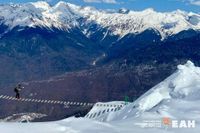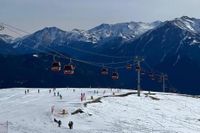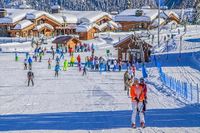From December to mid-April, ski resorts across Russia have seen a significant uptick in visitors, particularly from the Sverdlovsk region. According to a joint study by MegaFon and the corporation Turizm.RF, Krasnaya Polyana in Sochi emerged as the most popular destination, attracting 58% of active recreation enthusiasts from the region. Following closely is Sheregesh in the Kemerovo region, which drew 13% of Sverdlovsk residents, while 7% opted for the slopes of Prielbrusye. Other notable mentions include Dombai and Arkhyz, which also made it to the top five winter resorts.
Dmitry Smirkin, Director for Public Relations and Marketing at Turizm.RF, highlighted the growing popularity of ski tourism, stating, "Fifteen years ago, Sochi was exclusively associated with summer beach vacations. The Olympics and the subsequent unprecedented surge in domestic tourism transformed the city into a year-round vacation destination for millions of tourists. The coastal and mountain clusters have become a model for the entire country on how to develop tourist territories." This transformation has not only bolstered tourism but has also enhanced the local economy.
In response to the surge in visitors, MegaFon modernized approximately 80 base stations in the Sochi mountain cluster, which includes the villages of Krasnaya Polyana and Esto-Sadok, as well as slopes, lifts, recreation areas, shopping complexes, and railway routes. The improvements have resulted in mobile internet speeds reaching 225 Mbit/s at the base of the resort and 160 Mbit/s in the mountainous areas. Alexey Titov, the Technical Director of MegaFon, noted, "Stable mobile communications in the mountains are not only comfort but also safety. Tourists and locals can contact their loved ones and access emergency services at any time."
According to the study, mobile traffic in ski locations nationwide increased by 16% compared to the previous year, while the overall tourist flow rose by 12%. In Krasnaya Polyana alone, mobile traffic surged by nearly a quarter during the 2024-2025 ski season. Arkhyz and Dombai also reported significant growth in mobile traffic demand, with increases of 23% and 9%, respectively. This growth has allowed these resorts to surpass previously popular Siberian winter destinations.
Notably, Prielbrusye ranked fourth, particularly favored by tourists from major cities like Moscow, St. Petersburg, and Volgograd, who increased their data traffic by 9%. Sheregesh rounded out the top five, showing a 13% increase in mobile internet demand. The enhancements in telecommunications infrastructure have ensured that internet speeds remain high, even during peak loads.
The increasing number of visitors to these ski resorts reflects a broader trend in Russian tourism, as more people seek year-round recreational activities. The demographic of winter sports enthusiasts is also evolving. While men aged 36-45 constitute 57% of all mobile traffic in winter resort locations, the number of women participating in skiing is on the rise, increasing by 11% compared to last year.
In Arkhyz, additional telecom equipment was installed to maintain high internet speeds during peak times, and existing digital infrastructure was modernized. This upgrade not only benefits ski resorts but also extends to shopping areas, cultural and religious institutions. The introduction of LTE-2100 base stations has proven effective in expanding network capacity.
As the ski season continues, the focus on enhancing the tourist experience through improved telecommunications infrastructure demonstrates a commitment to ensuring that both locals and visitors can enjoy their time in the mountains safely and efficiently. The developments in Sochi and beyond serve as a blueprint for other regions looking to enhance their tourist offerings.
Looking ahead, the popularity of ski tourism in Russia shows no signs of slowing down. With the success of resorts like Krasnaya Polyana, Arkhyz, and Dombai, the industry is likely to continue evolving, attracting more visitors and generating economic growth. As Dmitry Smirkin pointed out, these trends indicate that new tourist hotspots are emerging across the country, which is undoubtedly an important trend for the future of Russian tourism.
In summary, the ski resorts in Russia are not only becoming more popular but are also adapting to the needs of modern tourists. The significant investments in infrastructure and telecommunications are paving the way for a more enjoyable and secure experience in the mountains. As more people discover the joys of winter sports, the future of ski tourism in Russia looks bright.






